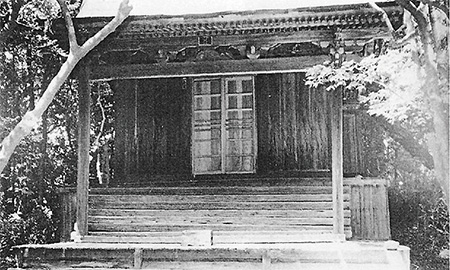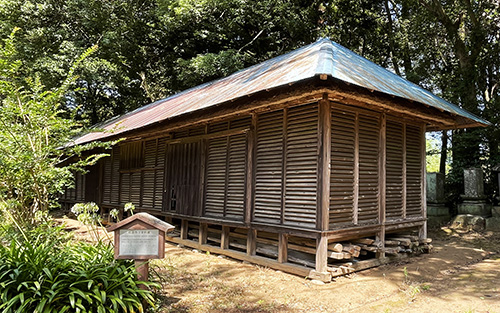

東国三社探訪での「スピンアウト」だけれど、今回、成田空港の近傍の龍角寺を深掘りしてみた。当初の興味はその創建時の状況から、中央の古代氏族・蘇我氏との関係性に導かれたのだけれど、現地の様子を写真に収め、いくつかの物証、本尊や研究者のみなさんの探究に触れて、リアリティが自分のなかで形成されていった次第であります。古建築探索の醍醐味なのだと思います。
さてこの古刹・龍角寺境内敷地には「摂社」的な建築が2つ建っている。
ひとつは写真の「二荒〜ふたら〜神社」。この旧二荒神社本殿は、平成2年(1990)に現在の社殿に造替されたが、旧社殿は寛文8年(1668)の建立と解体部材の墨書から判明しているとのこと。下の写真は建て替えられる前の1668年当時からの旧社殿を撮影したもの。参照引用資料は、早稲田大学での龍角寺関連展示での発表資料:早稲田大学理工学術院・小岩正樹先生の「龍角寺の近世建築」より。
二荒山神社は宇都宮にあって日光信仰のルーツとも言われる。家康が「東照大権現」となって江戸城を守護する位置・日光に神となって眠るワケだけれど、そういった歴史変動がこの龍角寺境内にも及んで、摂社として建てられたのではないかと想像できる。資料によると、建築年代を示す墨書から考えれば建築年代は1668年である可能性が高いとされている。同時にこの建築に関わった工匠たちの個人名・属性もわかるとされた。
〜建立年と工匠名が記された部材の墨書きから大工・増渕伊兵衛守勝のほか「小工」「木引」の名が確認でき、いずれも常陸国下館市野辺村出身という。増渕伊兵衛はすぐ近くの安食村に居を構えており移住大工と言えよう。ほかに墨書に登場する人物には、龍角寺村領主であった佐倉藩主松平乗久や「龍角寺弟子玄榮」「大門善十郎よりきしん(寄進)」などとある〜<以上前掲資料より要旨抜粋>
こういう建築記録からは300年以上の時空を超えて伝わってくる感慨がある。

さらに、こちらの校倉建築は、明治初年の資料庫建築で、成田空港建設にともなってこの境内に移築保存されたものとされている。三里塚にあった宮内庁下総御料牧場から空港建設に伴って移築された。御料牧場自体は国有資産としてその敷地は成田空港に変貌していくことになる。
御料牧場は栃木県高根沢町に移転されたが、なぜその一部の校倉がこの地に移転されたのかの経緯は今のところ、不明。わたしたちの青春期の「成田空港反対闘争」という時代の「うずき」が、突然眼前に姿を現わす思い。やがて自分たちの生も歴史の中に眠っていく。輪廻転生・諸行無常と感慨深い。
建築と歴史状況を重ね合わせて先人の思いを掘り起こしていくという作業には、尽きぬ深みがある。一種のライフワークとして、今後とも取り組んでいきたいと思います。
English version⬇
Futaara Shrine, Koukura, and Ryukakuji Temple, the reincarnation of architecture (7) Exploring the Three Shrines of Eastern Japan – 14
From the calligraphy of Edo period architecture to the disappearance of artisans, and the lingering light of the Showa period and the lingering shadow of the Narita struggle. The cry of the architectural group that repose the souls of the times. The cry of the buildings that repose the souls of the times.
As a “spin-out” from my exploration of the three shrines in the eastern part of Japan, I decided to delve deeper into the Ryukakuji Temple near Narita Airport. My initial interest in the temple was guided by its relationship with the Soga clan, an ancient clan in the center of Japan, based on the conditions at the time of its founding, but after taking photographs of the site, and being exposed to several pieces of physical evidence, the principal image, and the research of researchers, a sense of reality was formed in my mind. I think this is the best part of exploring ancient architecture.
There are two “regent” buildings on the grounds of Ryukakuji Temple, an ancient temple.
One is the Futara Shrine in the photo. The main building of the former Futara Shrine was replaced with the current one in 1990, but it is known from the ink writing on the dismantled parts that the former shrine was built in 1668. The photo below shows the old shrine building from 1668, before it was rebuilt. Reference citation material is from a presentation material at an exhibition related to Ryukakuji Temple at Waseda University: “Early Modern Architecture of Ryukakuji Temple” by Dr. Masaki Koiwa, School of Science and Engineering, Waseda University.
Futaarayama Shrine is located in Utsunomiya and is said to be the root of Nikko worship. Ieyasu Ieyasu became “Tosateru Daigongen” and rested as a god in Nikko, the location that protects Edo Castle, and we can imagine that such historical changes must have extended to the precincts of Ryukakkakuji Temple, where the shrine was built as a regent shrine. According to the documents, the date of construction is highly likely to be 1668, based on the ink signatures that indicate the date of construction. At the same time, the names and attributes of the craftsmen involved in the construction are also known.
〜The year of construction and the ink inscriptions on the building materials show the name of the carpenter Ihee Masubuchi Morikatsu, as well as the names of “Kouko” and “Kibiki,” all of whom were from Nobe-mura, Shimodate City, Hitachinaka Province. Ihee Masubuchi is said to be an immigrant carpenter who settled in the nearby village of Ajiki. Other people who appear in the inked documents include Norihisa Matsudaira, lord of the Sakura domain, who was the lord of Ryukakuji Village, “Ryukakuji disciple Gensei,” and “Daimon Zenjuro, who donated the building to the temple.
These architectural records convey a sense of excitement that transcends the time and space of more than 300 years.
Furthermore, it is believed that this schoolhouse was built in the early Meiji period (early 1868) and was moved and preserved in the precincts of this building in conjunction with the construction of Narita Airport. It was moved from the Imperial Imperial Household Agency’s Shimofusa Imperial Farm in Sanrizuka to this location in conjunction with the construction of the airport. The Imperial ranch itself became a national property, and the site was transformed into Narita Airport.
The Imperial ranch was moved to Takanezawa-cho, Tochigi Prefecture, but the circumstances as to why a portion of the schoolhouse was moved to this location are currently unknown. The “tingle” of the “struggle against Narita Airport” of our youth suddenly appeared before our eyes. Eventually, our own lives will also fall asleep in history. I was deeply moved by the reincarnation of life and the impermanence of all things.
There is never a dull moment in the process of unearthing the thoughts of our predecessors through the superimposition of architecture and historical circumstances. I would like to continue working on this project as a kind of lifework.
Posted on 8月 18th, 2023 by 三木 奎吾
Filed under: 日本社会・文化研究, 歴史探訪







コメントを投稿
「※誹謗中傷や、悪意のある書き込み、営利目的などのコメントを防ぐために、投稿された全てのコメントは一時的に保留されますのでご了承ください。」
You must be logged in to post a comment.